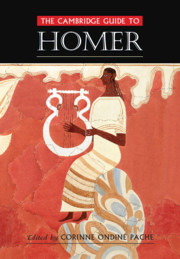Book contents
- The Cambridge Guide to Homer
- The Cambridge Guide to Homer
- Copyright page
- Contents
- Figures
- Notes on the Contributors
- General Introduction
- Part I Homeric Song and Text
- Part II Homeric World
- Part III Homer in the World
- Introduction
- Homer in Antiquity
- Homer and the Latin West in the Middle Ages
- Homer in Greece from the End of Antiquity 1: The Byzantine Reception of Homer and His Export to Other Cultures
- Homer in Greece from the End of Antiquity 2: Homer after Byzantium, from the Early Ottoman Period to the Age of Nationalisms
- Homer in Renaissance Europe (1488‒1649)
- Homer in Early Modern Europe
- The Reception of Homer since 1900
- Homer: Image and Cult
- Key Topics
- Bibliography
- Index
Introduction
from Part III - Homer in the World
Published online by Cambridge University Press: 22 February 2020
- The Cambridge Guide to Homer
- The Cambridge Guide to Homer
- Copyright page
- Contents
- Figures
- Notes on the Contributors
- General Introduction
- Part I Homeric Song and Text
- Part II Homeric World
- Part III Homer in the World
- Introduction
- Homer in Antiquity
- Homer and the Latin West in the Middle Ages
- Homer in Greece from the End of Antiquity 1: The Byzantine Reception of Homer and His Export to Other Cultures
- Homer in Greece from the End of Antiquity 2: Homer after Byzantium, from the Early Ottoman Period to the Age of Nationalisms
- Homer in Renaissance Europe (1488‒1649)
- Homer in Early Modern Europe
- The Reception of Homer since 1900
- Homer: Image and Cult
- Key Topics
- Bibliography
- Index
Summary
The Iliad and Odyssey, once they had become books like other books, with an author (Homer) who in turn developed a biography (or rather several competing biographies), rapidly became school texts, at least in Classical Athens. Their status in the Archaic period (roughly 700 to 480 b.c.) is unclear, but both before and after the wars of Persia and Greece (492‒479 b.c.) Homer’s poems seem to have served a purpose in Greek culture broadly comparable to those of the bearers of traditional lore in many cultures, straddling the beginnings of widespread literacy – of the Mahabharata and Ramayana in India, the Shahnameh and its obscure precursors in Persia, the stories of Nasreddin Hoja in Turkey, and the bards of the Eddas and of the Irish epics, to name only a few of the most familiar. But from the Classical period onwards, the Iliad and Odyssey have had a new life as books, at first parallel to the performance tradition and eventually outliving and superseding it, and wherever there have been readers of Greek (and, paradoxically, in many places where such have been few or absent) the epics have maintained their cultural presence.
- Type
- Chapter
- Information
- The Cambridge Guide to Homer , pp. 411 - 414Publisher: Cambridge University PressPrint publication year: 2020

